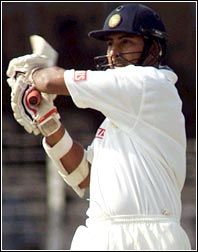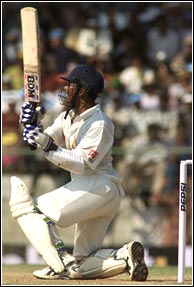 Home > Cricket > Diary archives
Home > Cricket > Diary archivesSeptember 26, 2001
India's opening balance
Faisal Shariff
Well begun is half done, goes the old adage. The Indian Test opening partnership has been the bane of Indian cricket when touring overseas. The early fall of a wicket has forced the teamís best batsmen (read middle-order) to play a dual role; see the shine off the ball as well as attack and seize the initiative.
And, yet again, as India travels to South Africa for a Test series, a lot depends on India's opening pair of Shiv Sundar Das and Sadagoppan Ramesh. To say that they are as different as chalk and cheese would be stating the obvious. The variation is palpable and stark as is their approach to life off the field.
 While Ramesh claims he refuses to even look at the willow once back from the ground, the Oriya lad shadow bats in front of the mirror, watching his feet, checking if his head is still dropping a wee bit more than it should.
While Ramesh claims he refuses to even look at the willow once back from the ground, the Oriya lad shadow bats in front of the mirror, watching his feet, checking if his head is still dropping a wee bit more than it should.
Ramesh reads Sidney Sheldon and also enjoys a 'Tinkle' (childrenís comics) while Das canít make up his mind about which channel to watch on television.
And yet, they respect each other immensely.
Says Ramesh, "There is a lot of respect as well -- I admire his approach to the game."
The two of them average a healthy 44 per innings, which would make a huge difference on the bouncy tracks of South Africa.
Coach John Wright mentioned the opening partnership as the lone positive of the Sri Lankan series.
"The main thing is the fact that we have set ourselves a goal -- to forget individual scores. After we were criticised earlier for not delivering, we decided to get 50-run partnerships, minimum. So our target is, at all times, a team score of 50/0, without bothering about our individual scores. Right now, we average around 44 per innings, but we need to be more consistent," explains Ramesh.
Despite being a left-right combination, Ramesh has his own explanation for their success. "Not really, I've always batted with right-handers. I guess what works for us is that we play differently, and that is what makes things hard for the bowlers to adjust to. We also concentrate on rotating strike a lot, because that forces the bowler to constantly change his line.
"Das has got very strong basics. Bowlers bowl short to him and try to push him back because of his solid defence. He is a good driver of the ball though. When I bat, they have to pitch it up because I leave the short balls well. So their line to me is a tempting driving line outside off."
Talk of adjustments for the South African tour and Das points out that Pollock will be the most difficult to face.
"I have to mentally prepare to play on bouncy tracks; so right now I am playing with plastic balls because they bounce a lot. The wickets in South Africa are grassy, and I expect they will bowl short a lot so I am also practising my cuts, slashes, shots like that. I have asked for tapes of [Allan] Donald, [Shaun] Pollock and [Jacques] Kallis bowling, so that I can watch them and prepare to face them; it will help me visualize how they will come at me.
"It helps a lot if you are mentally prepared; if you have a mental image of the bowler you are going to face."
Pose the same question to Ramesh and you have a dismissive nod, and "No preparations" reply.
"I have learnt during my time in international cricket that I am quite cool under pressure, and that could be a big asset for me in places like South Africa and Australia, where mind games play a big role. These tours actually start before we even get there; they use the media to their advantage, make statements about opposition players to demoralize them. The game starts before a single ball is bowled. I don't let pressure get to me. If you keep thinking of failing, you will.
"I know the wickets there are bouncy and hard, but there is no point in thinking constantly about it. I need to plan how to tackle that, and then relax and just go there and do it. People say that I havenít performed creditably overseas but I hope someone looks at how many Tests I have played overseas -- only three."
 The thinking was that Das is essentially a Test batsman -- until he forced his way into the one-day squad for South Africa through sheer weight of runs.
The thinking was that Das is essentially a Test batsman -- until he forced his way into the one-day squad for South Africa through sheer weight of runs.
Ask him about the adjustments he will have to make for the ODIs, and he says the practice games will be the key.
"My technique will not change a lot; in fact, it doesnít need to change. I only need to prepare mentally for the shift from the longer to the shorter version. I will need to rotate the strike a lot faster than I do in Tests. Being mentally tough will matter most. Also, I'll probably bat in the middle order, so I have to be mentally ready to rotate strike, and play more shots."
Sadagoppan Ramesh believes that there is one thing needed to make him perform at his best -- some competition for his place, in the form of a third opener.
Wright calls him special; his teammates talk of his composure under pressure; and fans moan that he has every shot in the book, yet, like in the past, he seems to pick only those shots that will get him out. Even in Sri Lanka he seemed to cruise to the forties and then give it away.
"I think I was too keen to get to my fifty and then go after the bowling. The keenness to get to my half-century got me worried, and I ended up playing loose shots.
"But there has been a lot of change in my batting. I am more solid now; I'm leaving the ball better than at any point in my career. It has now become a habit with me to let them go outside off-stump. Another thing I have worked on is playing straight. Earlier, I played my on-drives through midwicket; now I play it straighter, between bowler and mid on."
And even as the duo packs their bags with the extra burden of getting their team off to a good start, the real challenge will be the depth and spirit of this young and talented bunch.
Let's not forget that despite healthy partnerships in Sri Lanka, the Indian team failed to get huge totals. The strength of this team should not essentially be merely the opening partnership but the ability to achieve the target set, whether they are at 90/1 or 20/4. Therein lies the strength of the pack.
The Rediff Email Diary -- the complete archives
![]()
![]()
Email : Prem Panicker
©1996 to 2001 rediff.com India Limited. All Rights Reserved.